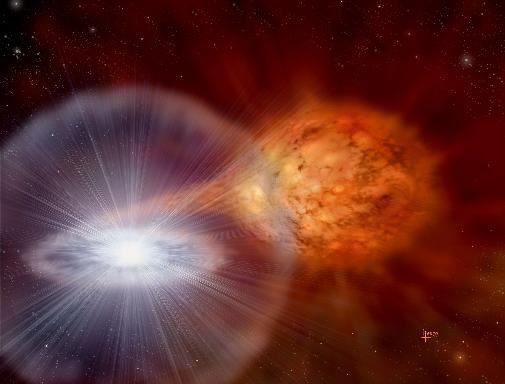[/caption]
An alert was raised March 11 when Japanese amateur astronomers announced what might have been the discovery of a new 8th magnitude nova in the constellation of Cygnus. It was soon realized that this eruption was not what it appeared to be. It was actually the unexpected nova-like erruption of a known variable star, V407 Cygni. Typically varying between 12th and 14th magnitude, V407 Cyg is a rather mundane variable star. So what caused this well-behaved star to suddenly go ballistic?
V407 Cyg is a symbiotic variable. These are close, interacting binary pairs usually containing a red giant and a hotter, smaller white dwarf. They orbit a common center of gravity inside a shared nebulosity. A typical symbiotic variable consists of an M type giant transferring matter to a hot white dwarf via its stellar wind. This wind is ionized by the white dwarf, giving rise to the symbiotic nebula.
Symbiotic variables are complex systems with many sources of variability. They can vary periodically due to the binary motion, the red giant can vary due to pulsation, the stars may be obscured by circumstellar dust, or the light emitted my change due to the formation of giant star spots. The white dwarf component may glow more or less constantly as it accretes material from the red giant and heats it up at a steady rate, or the material may form an accretion disk around the white dwarf, like in dwarf novae. Mass accreted onto the white dwarf can result in flickering and quasi-periodic oscillations. If there is a sudden increase in the rate of accretion, or the material in the accretion disk reaches a point of instability and crashes down onto the surface of the white dwarf the symbiotic system may undergo a nova-like eruption.
About 20% of symbiotics consist of a Mira-type variable as the giant of the pair. These binaries reside in much dustier envelopes. V407 Cyg is one of these dusty, Mira-type symbiotics. Its typical variation of a few magnitudes is due mainly to the pulsation of the Mira component of the system. Astronomers had never before witnessed a nova-like outburst of this interacting binary. You can imagine their surprise when Japanese amateurs, searching for novae along the galactic plane, suddenly detected this mild mannered, dusty Mira, symbiotic variable glowing nearly 100 times brighter than ever before.
That was just the beginning of the story. The first new spectra taken of the system, on March 13th, was different from any ever recorded for this star or any other symbiotic Mira variable in outburst. The normal absorption spectra of the Mira star was completely overwhelmed by the blue continuum of the outbursting white dwarf. The characteristics of the emission spectra revealed two distinct types of activity. One was the relatively slow ionized wind of the Mira star. The other looked like the fast expanding ejecta of a nova outburst. In fact, the spectrum looked remarkably similar to the symbiotic recurrent novae, RS Ophiuchi.
Typical outbursts of known symbiotic binaries, and symbiotic Miras in particular, usually exhibit a very slow rise to maximum, taking months, and no real significant mass ejection. This appears to be a much more quickly evolving and violent event, more like the eruptions of the recurrent novae RS Oph and T CrB. V407 Cyg may join this rare class of symbiotic recurrent novae.
As if that weren’t enough, another twist was added to the story on March 19th, when the Large Area Telescope (LAT), on board the Fermi Gamma-ray Space Telescope detected the star in gamma-rays, something never observed in a symbiotic system before. The gamma-rays could be caused by shock driven acceleration of the ejected material, and its capture by strong magnetic fields within the system.
Like many novae and recurrent novae outbursts, this eruption may last for weeks or months and the variation in light output could be quite complex and interesting. Because the giant secondary is losing mass, the system is likely to have a large amount of circumstellar material. The ejected shell from the nova explosion on the white dwarf will interact with this material as the shell propagates outward, and will likely produce a wide variety of variable phenomena.
V407 Cyg has our attention now, and professional and amateur astronomers will be keeping a close eye on it from now on.


Monitoring of this star by both amateurs and professionals for signs of a high velocity or ‘superluminal’-expanding nebula(light-echo) would seem to be in order.